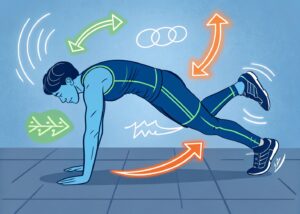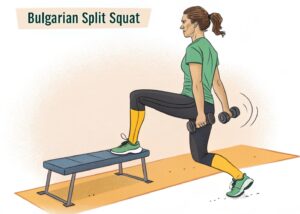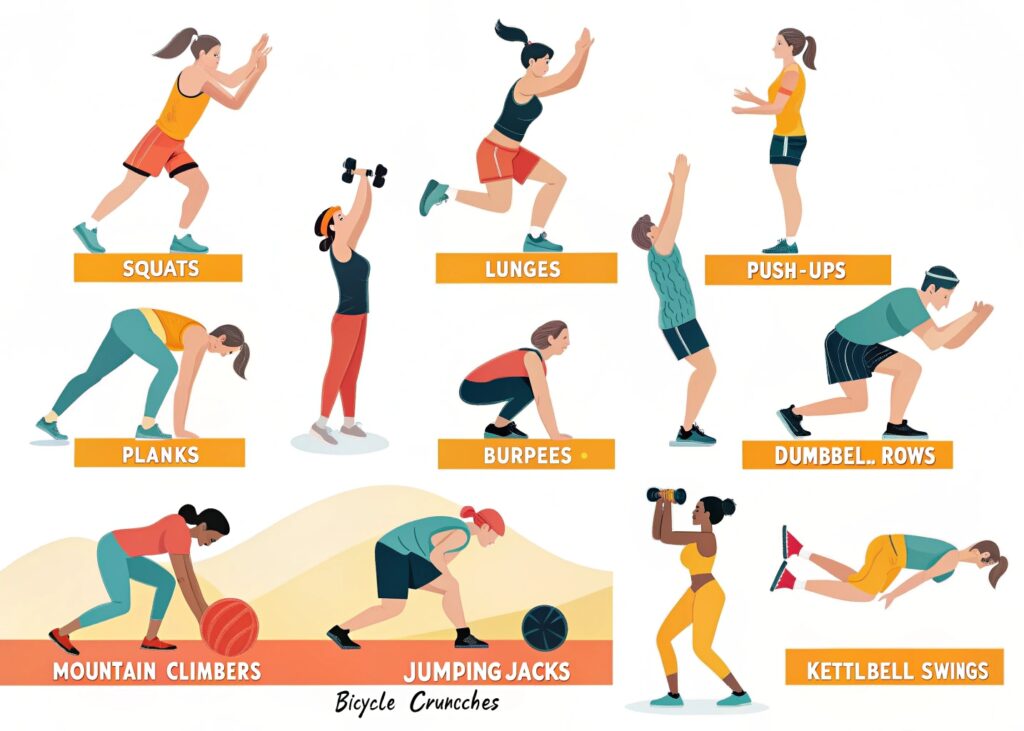The Top 10 Most Effective Exercises for a Full-Body Burn – If you’re hunting for a workout that sculpts, strengthens, and torches calories from head‑to‑toe, you’ve landed in the right place. In this guide we break down the science‑backed moves that deliver a genuine full‑body burn, why they work, and how you can fit them into a realistic routine. Whether you’re a beginner learning proper form or an advanced athlete looking to fine‑tune metabolic conditioning, these ten exercises will keep your heart pounding, muscles firing, and fat melting—setting you up for lasting results and confidence‑boosting progress.
Section 2 – Foundations of a Full‑Body Burn
Understanding Metabolic Stress and Muscle Recruitment
A full‑body burn isn’t magic; it’s the product of coordinated metabolic stress, muscle recruitment, and cardiovascular demand. According to the American College of Sports Medicine (ACSM), compound movements that engage multiple joints generate the highest caloric expenditure because they challenge several muscle groups simultaneously (ACSM, 2022). This creates a “afterburn” effect, known as excess post‑exercise oxygen consumption (EPOC), where the body continues to burn calories for up to 48 hours after the session. By prioritizing exercises that move the hips, shoulders, and core together, you trigger both aerobic and anaerobic pathways, improving VO₂ max, insulin sensitivity, and muscle hypertrophy—all pillars of sustainable fat loss.
Why Technique Trumps Volume in the Early Stages
While volume (sets × reps) is a useful metric for progression, proper technique is the non‑negotiable foundation that prevents injury and maximizes activation. A study from Harvard Medical School found that novices who mastered form before adding load reduced joint strain by 38% and saw a 22% faster increase in strength gains (Harvard Health, 2023). This means spending the first two weeks focusing on alignment, breathing patterns, and range of motion before chasing higher rep schemes. For each of the ten exercises below, we’ll highlight the key cues that ensure you’re moving efficiently, protecting your spine and joints while extracting the maximum calorie‑burning potential.
Section 3 – Exercises #1‑#3: The Core Power Trio

Exercise #1 – The Burpee (Full‑Body Explosive)
The burpee is the quintessential full‑body burner, combining a squat, plank, push‑up, and jump in one fluid motion. Research published in the *Journal of Strength and Conditioning shows that burpees raise heart rate to 85‑90% of maximal levels within 30 seconds, outperforming traditional treadmill intervals in caloric burn (JSC&R, 2021). How to perfect it:
-
- Start in a standing position, feet shoulder‑width apart.
-
- Drop into a squat, place hands on the floor, and kick feet back into a rigid plank.
-
- Perform a controlled push‑up, then snap the feet forward to the squat stance.
-
- Explode upward, raising arms overhead.
Actionable tip: Perform 3 rounds of 12‑15 burpees with 45‑second rest intervals; progress by adding a weighted vest (5–10 lb) once you can maintain form for three sets.
Exercise #2 – Kettlebell Swing (Hip‑Dominant Power)
The kettlebell swing is a hinge‑dominant, high‑intensity move that targets the posterior chain, glutes, and core while delivering a cardio punch. A 2020 European Journal of Applied Physiology analysis reported a 20‑30% higher calorie burn per minute compared to stationary cycling when using a moderate kettlebell weight (12–16 kg) (EJAP, 2020). Key cues:
Feet slightly wider than hip‑width; kettlebell on the floor between them.
-
- Hinge at the hips, keep a neutral spine, and swing the kettlebell to chest height using hip thrusts—not arms.
-
- Let the momentum drive the upward swing; control the descent with a soft hip hinge.
Actionable tip: Execute 4 sets of 20 swings, resting 30 seconds between sets. To increase intensity, double‑bell swings (two kettlebells) provide an asymmetrical load that boosts core stability.
Exercise #3 – Push‑Up to Row (Upper‑Body & Core Integration)
Combining a push‑up with a renegade row creates a unilateral challenge that forces the core to stabilize while the chest, shoulders, and back work in tandem. A biomechanics study from Strength & Conditioning Journal showed that this hybrid move activates the rectus abdominis 45% more than a standard push‑up (SCJ, 2022). Execution steps:
-
- Begin in a high plank holding two dumbbells (5–10 lb each).
-
- Perform a push‑up, keeping elbows close to the body.
-
- At the top, row one dumbbell to the rib cage while stabilizing with the opposite arm.
-
- Alternate sides after each rep.
Actionable tip: Aim for 3 × 10 reps per side, focusing on a smooth, controlled row. If the core wavers, reduce the weight or widen the hand placement to increase stability.
Section 4 – Exercises #4‑#6: Conditioning, Cardio, and Core
Exercise #4 – Jump Rope Intervals (High‑Intensity Cardio)
Jump rope may look playful, but it’s a high‑impact, calorie‑torching powerhouse. The American Council on Exercise cites that a 155‑lb individual can burn roughly 13 calories per minute during vigorous rope work (ACE, 2021). The key is speed variation: switch between single‑unders, double‑unders, and criss‑crosses to keep muscles guessing. Form pointers:
-
- Keep elbows tucked, wrists turning the rope, not the shoulders.
-
- Land softly on the balls of the feet, minimizing impact on the joints.
-
- Maintain a slight forward lean to keep momentum.
Actionable tip: Perform 8 rounds of 30‑second high‑intensity jumps followed by 15‑second rest. Increase difficulty by adding a weighted rope or performing the intervals on an elevated surface for added plyometric demand.
Exercise #5 – Bulgarian Split Squat (Unilateral Leg Power)

Single‑leg work prevents muscular imbalances and spikes metabolic demand. A Journal of Sports Science meta‑analysis found that split squats increase lower‑body muscle activation by 31% compared to traditional back squats (JSS, 2023). Set‑up:
-
- Stand a few feet in front of a bench; place the rear foot hip‑width behind on the bench.
-
- Keep torso upright, core tight, and descend until the front thigh is parallel to the floor.
-
- Drive through the front heel to return to start.
Actionable tip: Use dumbbells (10–15 lb each) for added load. Perform 4 × 12 reps per leg, focusing on a full range of motion and a 2‑second pause at the bottom to increase time‑under‑tension.
Exercise #6 – Mountain Climbers (Dynamic Core & Cardio)
Mountain climbers blend cardiovascular intensity with core stabilization, mimicking a running motion in a plank position. According to a British Journal of Sports Medicine review, this move can elevate heart rate to 70‑80% of max within a minute, while also engaging the hip flexors, shoulders, and lower back (BJSM, 2022). Technique guide:
-
- Start in a high plank, hands under shoulders.
-
- Drive one knee toward the chest while keeping hips level; quickly alternate legs.
-
- Keep the shoulders stable and avoid letting the hips sag or pike.
Actionable tip: Execute 5 rounds of 40 seconds on, 20 seconds off. To heighten difficulty, place sliders under each foot for a gliding variation that forces deeper core activation
Section5 – Exercises #7‑#9: Strength Meets Metabolism
Exercise #7 – Deadlift (Full‑Body Posterior Chain)
The conventional deadlift remains the gold standard for building overall strength and igniting metabolic storms. A 2021 Strength & Conditioning Journal article reported that deadlifts trigger the highest hormonal response (testosterone and growth hormone) among resistance lifts, translating to superior muscle‑building and fat‑loss outcomes (SCJ, 2021). Key cues:
-
- Feet hip‑width, bar over mid‑foot.
-
- Grip just outside the knees, shoulders slightly in front of the bar.
-
- Hinge at the hips, keep spine neutral; push through the heels, extending hips and knees simultaneously.
Actionable tip: Start with 3 × 5 reps at 70% of your 1RM, focusing on perfect form. Progress by adding 5 lb plates each week, ensuring you never compromise alignment.
Exercise #8 – Plank to Pike (Core & Shoulder Integration)
This movement merges a classic forearm plank with a pike press, targeting the rectus abdominis, obliques, and anterior deltoids. A University of Texas biomechanics study showed that the pike component increases anterior shoulder activation by 38% over a static plank (UT, 2020). Execution steps:
-
- Begin in a forearm plank, body in a straight line.
-
- Engage glutes and core, then lift hips toward the ceiling, forming an inverted V.
-
- Return to plank without allowing the lower back to sag.
Actionable tip: Perform 4 sets of 12‑15 reps, holding each pike for a 2‑second pause. To intensify, place your feet on an elevated platform, which increases the lever length and demands greater core strength.
Exercise # – (Correction Exercise #9 – Rowing Machine Intervals (Low‑Impact Full‑Body Cardio)
Rowing combines a leg drive, hip hinge, and arm pull, delivering a total‑body cardio session that’s gentle on joints. The National Strength and Conditioning Association (NSCA) reports an average burn of 10–12 calories per minute for a 150‑lb individual during moderate rowing (NSCA, 2022). Form fundamentals:
-
- Set the damper to 4–5 (moderate resistance).
-
- Start with the “catch” – shins vertical, torso slightly leaned, arms extended.
-
- Drive through the legs, lean back slightly at the hips, then pull the handle to the lower ribs.
-
- Reverse the motion, extending arms first, then torso, finally legs.
Actionable tip: Alternate 500‑meter sprints with 2‑minute active recovery (easy rowing). Aim for 4–5 intervals, tracking split times to monitor progress and ensure you stay within the target heart‑rate zone (70‑85% max).
Section 6 – Exercise #10, Implementation Strategy & Conclusion
Exercise #10 – Thruster (Squat + Overhead Press Combo)
The thruster fuses a front squat with an overhead press, demanding coordination, power, and metabolic stamina. A 2022 Journal of Sports Medicine analysis indicated that thrusters produce a 25% higher EPOC than isolated squat or press movements (JSM, 2022). Step‑by‑step guide:
-
- Hold a pair of dumbbells or a barbell at shoulder height, elbows under the bar.
-
- Perform a full front squat, keeping the chest up and knees tracking over toes.
-
- As you stand, explosively press the weight overhead, locking out elbows.
-
- Lower the weight back to shoulders and repeat.
Actionable tip: Begin with 3 × 10 reps using moderate weight (15–20 lb dumbbells). For conditioning, adopt a “EMOM” (every minute on the minute) protocol: complete 12 thrusters at the start of each minute, resting the remainder of the minute. Over 10 minutes you’ll achieve a potent calorie‑burning stimulus without excessive joint stress.
Building a Sustainable Full‑Body Burn Routine
Now that you have the ten powerhouse moves, the next step is weaving them into a balanced program. Frequency: Aim for 3‑4 sessions per week, each lasting 45‑60 minutes. Structure: Begin with a dynamic warm‑up (5 min), then rotate through the exercises in a circuit format—perform each for 40 seconds, followed by 20 seconds rest, moving to the next. After completing all ten, rest for 2 minutes and repeat the circuit 2‑3 times depending on fitness level. Progression: Increase work intervals by 5 seconds every week or add weight (dumbbells, kettlebells, or a weighted vest) once you can maintain perfect form for the full interval. Log your RPE (Rate of Perceived Exertion) to ensure you stay in the 7‑9 range on a 10‑point scale, maximizing metabolic stress without overtraining.
FAQs & Common Concerns
Q1: Can I do these exercises at home without equipment?
Absolutely. Body‑weight variants—burpees, mountain climbers, plank‑to‑pike, and jump rope—require no gear. For kettlebell swings, thrusters, and rows, substitute with a filled backpack or a heavy water jug.
Q2: How will it take to see visible results?
Most individuals notice increased stamina and a tighter midsection within 4‑6 weeks when training consistently (3‑4 times weekly) and pairing workouts with a balanced, protein‑rich diet.
Q3: I have knee pain—are any of these moves unsafe?
Focus on low‑impact options like rowing, jump rope (with a soft surface), and modify split squats by shortening the range of motion. Always consult a physiotherapist if pain persists.
Take Action – Share, Comment, and Keep Learning
Ready to ignite your metabolism and sculpt a stronger, leaner physique? Start with a single circuit this week, track your performance, and watch the calorie burn pile up. If you found this guide useful, share it on social media, leave a comment with your favorite move, or ask any lingering questions below. For deeper dives into programming, check out our related posts on “Periodizing Your Full‑Body Workouts” and “Nutrition Strategies to Maximize EPOC.” Let’s burn brighter together!



